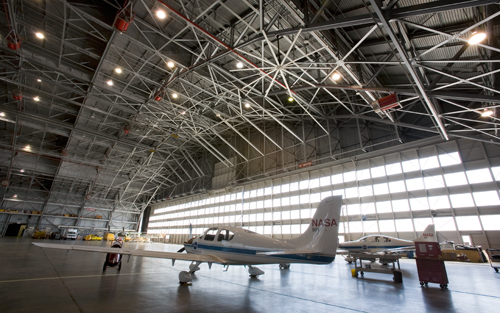Large, Low Velocity Fans: Making Energy Efficiency a Breeze
Necessary Space Above the Fan
The minimum amount of space above the fan depends on its size. Large, low velocity ceiling fans generally need 2 to 7 feet of space above the top of the winglets. Installing fans closer than the recommended distance from the ceiling may result in less than optimum performance. For the foils, a minimum clearance of 2 feet in all directions the is recommended for safety and performance; an additional 2 feet is needed at the tips of the foils. Ideally, the fan should be placed inside the lighting grid at the same height as the lights or slightly higher, or replace the lighting fixture with a fan-mounted light.
 |
NASA's Langley Research Center uses large, low velocity fans to keep hangars comfortable and aircraft safe. Photo Courtesy of Big Ass Fans® |
Height Above the Floor
The ideal height of the fan above the floor is roughly one to two times the fan’s diameter. In reality, most fans are between 15 and 30 feet above the floor, although even that is not always possible. Mounting a large, low velocity fan with the bottom of the fan anywhere between 10 and 125+ feet above the floor can produce satisfactory results. Height, dimensions and square footage need to be taken into account when choosing the most appropriate model for a space. In tall, open spaces a larger diameter fan is typically needed to produce adequate air movement. Consult a fan expert to determine the appropriate fan size and mounting height for your application and desired results.
Fan Controls
Rather than wire the fan through the on/off switch, a fan controller is necessary for several reasons. The primary function of the fan control is to protect the fan motor and gear reducer (with gear-driven models) from destructive electrical and mechanical forces. The variable speed drive such as a VFD that most large, low velocity ceiling fans use, does not allow the fan motor to be damaged by running a current that is higher than it is capable of tolerating. It also stops and starts the fan gradually so the gear reducer is not subjected to excessive torque loads. In addition, the fan can be connected to the Building Automation System via the controller. And, in many cases, the fan controller is necessary in order to maintain the manufacturer's warranty.
Reversibility of Fans
Conventional ceiling fans are typically run in reverse because small fans cannot efficiently move air at very low speeds. Operating a small fan in reverse means that the high-velocity air from the fan moves across the ceiling, down the walls and finally reaches the occupants. By the time the air has traveled the distance from the fan to the occupant, the air is usually moving at a non-perceptible velocity — in other words, not causing a draft.
If the fan is designed to operate efficiently at very low speeds in the forward direction, as some large, low velocity fans are, there is no need to reverse the fan. Simply turning the fan slower in the forward direction will provide enough air movement to turn the air in the space over and reduce the stratification without causing drafts. By using running it in the forward direction, the fan will use two to four times less energy than a reversed fan.
It is also worth noting that if the airflow from the ceiling fan is reversed with airflow upward, even at lower speeds, the velocity of air across the ceiling above the fan is fairly high, typically around 400 fpm. However, if the ceiling fan is running at low speed with airflow downward, the airflow across the ceiling is low, typically 80 fpm or less. In short, reversing the air flow direction from ceiling fans in winter will cause the heat loss through the ceiling to increase. This means that more heat will be lost out of the ceiling, thus reducing the energy savings by destratifying the space.
Maintenance
Architects interested in determining the full life cycle cost implications of a fan will note that maintenance of the large, low velocity fan is minimal. Typically, it involves merely an annual dusting and inspection. An annual inspection would ideally involve the following:
- Check for the presence of the safety cable and shackle. The cable should be wrapped around the I-beam/angle irons, leaving as little slack as possible. The shackle should be securely tightened and located on the topside of the I-beam/angle irons.
- Ensure all mounting bolts (12x) are present and torqued to 98 ft·lbf (133 N·m). Ensure the lower cable is between the brackets of the lower yoke.
- Inspect motor terminations inside junction box and tighten if necessary.
- Check all connections in the fan controller and tighten as needed.
- Check gear reducer for oil leakage.
- Ensure all bolts (20x) securing airfoils to fan are present and torqued to 29 ft·lbf (39 N·m).
- Ensure airfoils are secured to one another by airfoil retainers (10x).
- Ensure bolts securing hub safety clips are present and torqued to 29 ft·lbf (39 N·m).
Additional Considerations
- Verify proper fan rotation. The fan should be turning counterclockwise when viewed from the floor.
- Dust airfoils, motor, and motor housing. If desired, use a gentle cleaner or degreasing agent to polish the foils.
Conclusion
Heeding the current focus on sustainable, energy-efficient design, large, low velocity ceiling fan manufacturers have made available a number of cost-effective cooling options that can work well aesthetically in any environment. Visually striking fans that are silent and capable of moving air effectively in summer, winter and transitional seasons can form a viable part of any structure's energy program.
|









